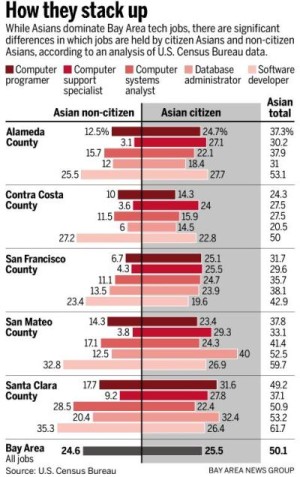This story and report came out last December, but I’ve only had time to get to this now. Asian Americans and Asian non-citizens 50.1% (versus 40.7 White, 4.2% Hispanic, 2.3% African American, and 2.7% other) of the San Francisco Bay Area technology-related workforce (“Silicon Valley” for the sake of simplicity). According to the San Jose Mercury News’ analysis of the latest Census Bureau data:
“An analysis of the Census data shows that among tech jobs held by Asians across the Bay Area, 25.5 percent belonged to citizen Asians — as the Census Bureau classifies them — with non-citizen Asians holding 24.6 percent of the jobs. The data helps underscore some of the rising tensions in tech workplaces around the Bay Area as white workers are displaced by both citizen- and non-citizen Asians, who are often allowed to work in the United States through H1-B visas that give preference to workers with tech skills.”
Why is this important?
Well, I think understanding this I think helps understand why the “perpetual foreigner” syndrome that many Americans feel about Asian Americans – even in California, where Asian Americans have had the oldest and one of the largest communities in America since the Gold Rush.
 Many Asians in the San Francisco Bay Area are technically “foreigners.” I personally know plenty of immigrants in Silicon Valley than have become naturalized U.S. citizens. Of course, this does not obviate an individual’s responsibility for making and understanding the difference between an Asian American and Asian, especially American-born Asian Americans (why is that concept so hard to comprehend?) Nothing annoys me more than when I am asked “Where am I really from?” when clearly, I am a clearly a native English speaker and most likely to have been born in the United States. (Are U.S. born Hispanics often asked, where are they really from? or is that just politically incorrect?)
Many Asians in the San Francisco Bay Area are technically “foreigners.” I personally know plenty of immigrants in Silicon Valley than have become naturalized U.S. citizens. Of course, this does not obviate an individual’s responsibility for making and understanding the difference between an Asian American and Asian, especially American-born Asian Americans (why is that concept so hard to comprehend?) Nothing annoys me more than when I am asked “Where am I really from?” when clearly, I am a clearly a native English speaker and most likely to have been born in the United States. (Are U.S. born Hispanics often asked, where are they really from? or is that just politically incorrect?)
One thing that I often do forget is that although my parents immigrated to the United States in the 1960s and I was born in the 1970s, the majority of Asians who have immigrated to the United States has been in the past decade or so – the second Gold Rush – the Internet and technology boom of the late 1990s and 2000s. According to Pew Research last year, 74% of Asian American adults were foreign born (Japanese Americans are the only ethnic group to have more born in the U.S. than abroad).
But the influx of foreign workers I do think help reinforce the stereotype of perpetual foreigner for even U.S.-born Asian Americans, and I think this has had professional consequences, especially Asian Americans who are in not technical roles. Because the majority of Asian Americans and Asians in Silicon Valley are in technology roles, the stereotype is that *all* Asian looking people are engineers. Not that it is bad to be an engineer, but not every Asian or Asian American is one (although I used to be one – an aerospace / mechanical engineer).
A former Vice President of Cisco, Buck Gee, who I’ve blogged about, co-wrote an editorial back in January around the time of this study, expressing his concern:
“Our Asian American workforce has grown to 50 percent of high-tech jobholders from 39 percent in 2000, as recently reported by the Mercury News. Yet in Silicon Valley’s 25 largest companies, only 12 percent of the executive leaders and 8 percent of board members are Asian Americans, a situation that has not substantially changed in the past decade. … Missing has been internal executive awareness of the leadership gap. We have found that most Bay Area executives, even those leading HR and diversity teams, are surprised with the data when we raise the question with them. But their subsequent comments are always supportive, with the discussion leading to what internal data can be reviewed and what can be done. So top-level visibility and support is paramount.”
Well, the Asian American figure, as expressed above is 25.5%. But even at that, a lot of the major Silicon Valley multinationals are global by their very nature. So whether you are talking about 25.5% Asian Americans or if you talking about 50% of Asian Americans and Asians, we are definitely underrepresented in leadership positions relative to our population. Perhaps this is a matter of time since many Asian immigrants have only arrived in the past decade or so, so more naturalized Asian Americans as well as U.S. born Asian Americans will be more represented in the executive suites in the future.
On a side note, PBS recently aired as part of their American Experience documentary series of the emergence of Silicon Valley in the 1950s and 1960, which is definitely worth viewing if you have any interest in the history of Silicon Valley. In the documentary, you can see that Silicon Valley back then was almost exclusively white.
graphic credit: Bay Area News
photo credit: JamesIrwin via photopin cc








